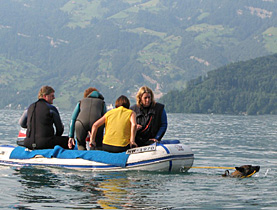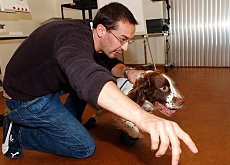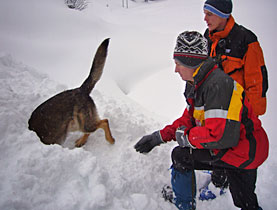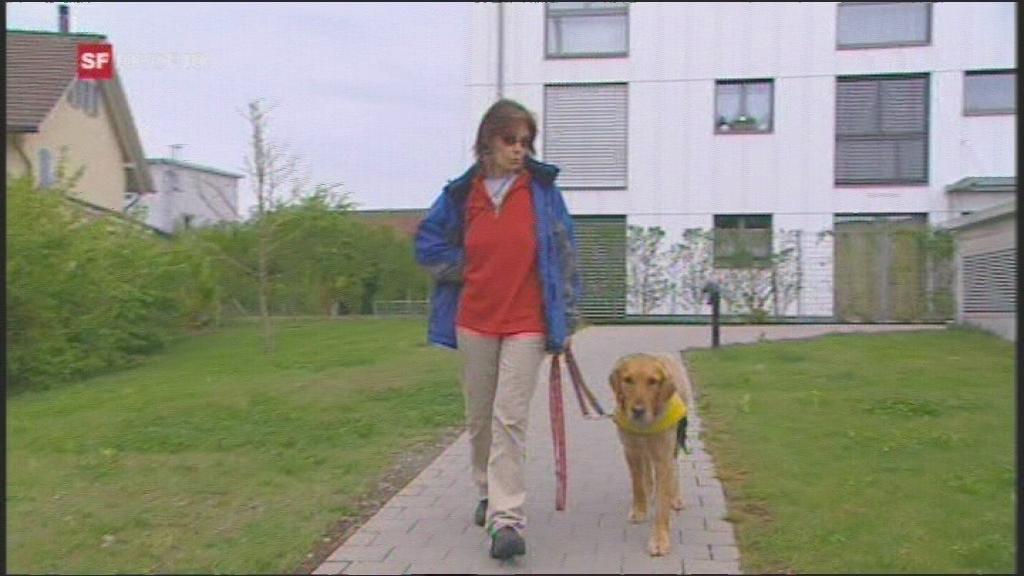Rescue dogs make a splash

Flailing and splashing, a panicky-looking woman cries out from the middle of the lake. A Belgian Shepherd leaps from a nearby boat into the water, a lifebelt in tow.
Moments later, the dog brings the floating ring to the struggling swimmer. She grasps it and holds on tight as the dog hauls her to the safety of the boat.
This is no ordinary canine; in fact, this is the reigning water rescue champion. Her name is Vhoopy (pronounced “whoopee”) and she’s a member of the Swimming Dogs Club of central Switzerland.
Meanwhile, the club’s human members take turns playing the role of the “victim”.
Vhoopy’s owner is club president Christa Wermelinger, who helped establish Swimming Dogs in 2000. A breeder of Belgian shepherds, Wermelinger has had a lot of success with her athletic pets.
“It’s fun for me and my dogs. We enjoy it together,” says Wermelinger. Currently, the club has about 20 active members who gather regularly to train their dogs on Lake Lucerne. It is one of just a handful of such clubs in Switzerland.
Size doesn’t matter
Any kind of dog can participate – the main prerequisite is a love of water.
“It’s very important that the dog is a good swimmer and that the dog loves the water,” says Bruno Burri, the club’s vice-president. Several breeds are represented in the club, for example: Belgian and German Shepherds, Labrador Retrievers, Newfoundlands and more.
“The size doesn’t matter. Medium-to-large sized dogs are preferred because of their power, but you can also do this sport with small to-medium-sized dogs,” says Burri.
Indeed, his black Pyrenean sheepdog is one of the smaller dogs in the club, yet on this evening, he makes hauling a boat carrying three men seem easy. When he gets back to shore, eight-year-old Lobo is still frisky enough to dance around for a treat.
According to Burri, the dog owners need strong swimming as well as teamwork skills – it’s not possible to train seriously without a group of people.
In terms of equipment, the club uses motor-powered dinghies, life buoys, life preservers and other small pieces to get the dogs used to carrying ropes in their mouths.
With the season running from April to October, the people wear dive suits for warmth as well as protection from canine claws. Meanwhile, the dogs wear sturdy harnesses to facilitate their handling.
Obedience is another key ingredient; it’s essential that the dogs heed their masters.
“In other sports, you have your dog right with you. But in water rescue work, you have to steer the dog over a big distance,” points out Burri.
There are a number of exercises that the dogs practise at four different ability levels. They begin with relatively simple tasks like fetching an object in the water and bringing it back to the person waiting on land.
At the top level, the tasks evolve into more complex exercises like assisting a lifeguard with the rescue of a non-swimmer. These dogs also need to be able to swim a full kilometre to demonstrate their endurance
Doggone good
So just what is it that motivates the dogs? Why are they so eager to help people in distress?
“It’s an illusion that dogs are happy to help people – they’re happy because they can do a job and they have a challenge. If you make the dog believe that bringing a life buoy to a person is a fun game, the dog will do his job with pleasure,” says Burri.
Even if it is just a game for them, the Swimming Dogs of central Switzerland are some of the nation’s best. Six-year-old Vhoopy placed first at last year’s national championship, followed by club colleagues Baja, a German Shepherd, and Luna, a Labrador Retriever, who took second and third place. In September they’ll head to Lugano for this year’s national championship.
As good as they are, the Swimming Dogs haven’t seen much real-life action. According to Burri, this is because Switzerland already has well-established, human-based rescue services available.
Still, that doesn’t eliminate the possibility of impromptu water rescue activities. Burri recalls the time that his boat’s motor died some 50 metres short of the shore. Lobo looked at him as if to say, “Shall I tow you?” Burri tossed a rope into the water and Lobo took it in his jaws as he paddled to the harbour.
Burri laughs as he remembers the reactions of the people sitting on lakeside benches: “I never saw such excited and amused faces!”
“Swimming Dogs Zentralschweiz” regularly hosts public training sessions.
Upcoming dates:
August 9, 2009: Flüelen, Uri
August 23, 2009: Flüelen, Uri
Sept. 7, 2009: Brunnen, Schwyz

In compliance with the JTI standards
More: SWI swissinfo.ch certified by the Journalism Trust Initiative






You can find an overview of ongoing debates with our journalists here. Please join us!
If you want to start a conversation about a topic raised in this article or want to report factual errors, email us at english@swissinfo.ch.